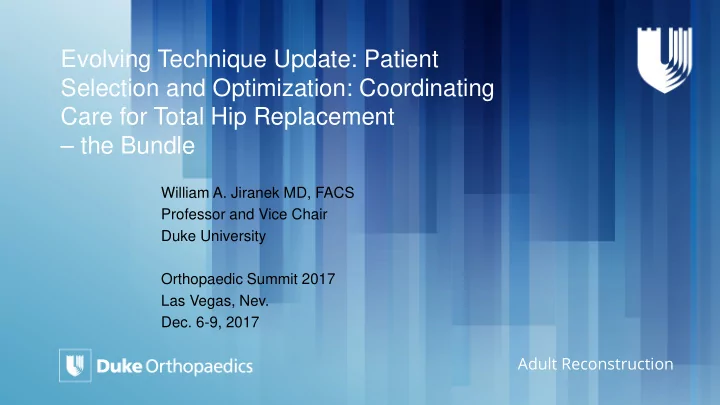

Evolving Technique Update: Patient Selection and Optimization: Coordinating Care for Total Hip Replacement – the Bundle William A. Jiranek MD, FACS Professor and Vice Chair Duke University Orthopaedic Summit 2017 Las Vegas, Nev. Dec. 6-9, 2017 Adult Reconstruction
Disclosure • Personal • Institution – Royalties – Research • Depuy and clinical – Consultant support: • Depuy • Depuy – BOD and • Stryker Committee • AAHK S, Hip Society
The AAHKS (Fehring) 11 ( Voss, Halsey) • Clinical Risk Factor ICD9 Code 15 Descriptor Morbid obesity BMI >40 278.01 Morbid Obesity Smoking 305.1 Tobacco use disorder Chronic anticoagulant use V58.61 Long‐term (current) use of anticoagulants. Chronic narcotic use 305.51 Opioid abuse, continuous Workmen’s compensation case V62.1 Adverse effects of work environment Previous intra‐articular infection 139.8 Late effect of other and unspecified infectious and parasitic diseases Congenital hip deformity 755.63 Other congenital deformity of hip Angular knee deformity >15 degrees 736.6 Other acquired deformity of knee 16 Previous ORIF hip 716.15 Traumatic arthropathy, pelvic region and thigh Previous ORIF knee 716.16 Traumatic arthropathy, lower leg Depression/psychiatric disease 300.9 Unspecified nonpsychotic mental disorder
What has helped Duke? • A preop committee that has power, and expertise, to delay surgery to optimize patients – Anesthesia (combined with preanesthesia testing) – APP staff trained in optimization • Developing systems to modify risks factors that are identified • Identifying a discharge plan preoperatively – This includes convincing the patient
Current Practice at Duke CJR – Risk Stratification Guidelines for Elective Primary Total Knee, Hip, Ankle Replacements- Duke Health System Consensus or Evidence Based- 2016 1. BMI 40 or greater 2. Active smoker- must begin cessation program 3. HgA1C > 7.5% (>8%?) 4. Albumin of 3 or less (?3.4 or less) 5. Anemia - Hgb less than 11 6. Thrombocytopenia- platelets less than 50k 7. ESRD on dialysis 8. Coronary stenting with or without AMI within the past 6 months (?12 months) 9. Stroke or TIA within previous 6 months 10. Any active infections; any open wounds on the lower extremity posted for surgery 11. Other significant issues- e.g. uncontrolled hypo-hyper thyroidism/ hyperparathyroidism, ASA 4, COPD on oxygen, etc. 12. Chronic high dose narcotic use (addiction) Patients that do not meet these criteria may occasionally receive surgery if reviewed and approved by a faculty panel at Preoperative Conference.
Scheduling note • Procedure plan • Risk Factor assessment – BMI >40 • TXA plan – Tobacco Presence • Antibiotic Plan – H/H (anemia) >12 • Anticoag Plan – Hgb A1C <8.5 • Therapy Plan – Albumin > 3.5 – Opioid Use < 30 MSO4 • Discharge Plan equivalalents
Duke Bundle Busters • Recognize • Optimize – Obesity – Patient buy-in – Nutrition – A system to deal with each of these risk factors – Nicotine – A committee that will review the patient – A1C – The will to delay surgery – Narcotics – Psychosocial • Catastrophising • No support structure – Cardiac
Sicker patients cost more – but which are the worst? • There are limits to optimization • Some comorbidities will lead to increased cost, you need to know that • Have a system to identify comorbid conditions accurately
How should we track risk factors ? N= 693 Duke 2012-14 CMS data from surgery + 90 days inc. payments made to outside institutions
Results Focus on the results that pertain to your purpose and hypothesis. Let us know the statistical significance of your most important findings. Give us the "meat" of your findings. Reddit.com Duke University Medical Center
Results MEDICARE PAYMENT INCREASE WITH COMORBIDITY Cost Bundle Target Payment Expon. (Cost) 32,000 30,000 TOTAL MEDICARE COST 28,000 26,000 24,000 22,000 20,000 0 1 2 3 4 5 6 7 8 9 10 NUMBER OF COMORBIDITIES • Medicare payments increased with increasing number of comorbidities (p<0.05) • Bundled payment remains static
Complications : Decrease SSI and Dislocation – the most bang for the buck! • Mean overall total CMS payment was $23,046.40 (n=693) 1. surgical site infection was $27,765 (n=15). 2. Dislocation was associated with an increase of $25,983 (n=3) 3. Deep vein thrombosis $15,141 (n=7) 4. fracture $10,504 (n=5) 5. pulmonary embolism $3,978 (n=14)
Conclusion • Hospital needs to set up pre anesthesia/ optimization clinic – Staffed by people who specialize on perioperative home • Program must optimize preop and minimize complications postop – Clear guidelines and programs for high risk comorbidities – An active communication system that monitors their progress. • Optimizing patients draws them into their care • Document clearly the patients at increased risk • Track your most common and expensive complications – Develop a plan to decrease them (for Duke it was SSI and dislocation)
Moving forward. Climbing higher. Moving forward. Climbing higher.
Recommend
More recommend